The Who and What of Pollination for bees
Intro Paragraph to go here
Honey Bee (Apis)
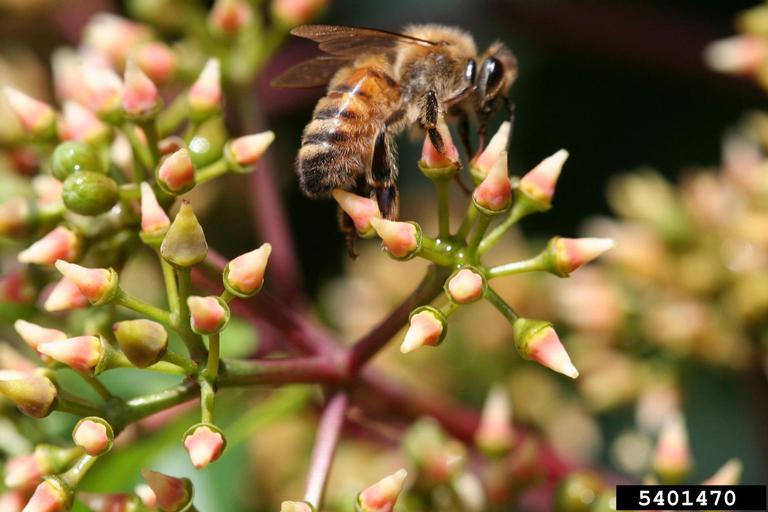
Lesley Ingram, Bugwood.org

Ryan Jones, Colonial Williamsburg Foundation, Bugwood.org
Honey bees are the most iconic and popularized of the bees, and for good reason. They are smaller and less stout than bumble bees and can be identified through lack of hair on the eyes, and lack of Tibial Spurs. Tibial spurs are protrusions on the end of the tibia which insects use to aid in digging, a problem no honey bee encounters through their life in a wax hive. Keep a look out for sacs of collected pollen on the bees hind legs. Identification of a hive can be a give away as to the identity of nearby bees as they live in an above ground wax hive. It is advised not to approach or agitate the hive without equipment or professional guidance as these bees will string to fend off intruders. When a honey bee stings, it leaves behind its venom sac and stinger, killing the bee. It is said the aroma of a bee sting is similar to a banana, however this smell is a pheromone that alerts other bees to danger.
Bumble Bee (Bombus)

Peter Wirtz, Bugwood.org

Mary C Legg, Mary C Legg, Bugwood.org
These stout bees are covered in dense hairs and share the same aposematic coloration of black and yellow bands to warn predators of their defense. They have a rounded abdomen, a contrast to the sharp edges of the honey bee. They also have hair on all segments of their body, as well as short hair on their eyes. Bumblebees also collect pollen, storming it in their hind legs, and are prolific pollinators. They are also social bees and build their nests underground, typically inhabiting pre-built underground structures such as abandoned rodent dens. The hole can be identified by the presence of bumble bees entering and exiting the hive, as well as dead bumblebee and larvae surrounding the entrance, placed there by workers cleaning the hive. These hives are significantly smaller in size compared to honey bees and do not overwinter, other than the queen that will diapause until spring. Because they do not overwinter, they do not stockpile honey in the same manner as honey bees, meaning they are beneficial primarily due to pollination.
Squash Bee (Peponapis & Xenoglossa)

Susan Ellis, Bugwood.org
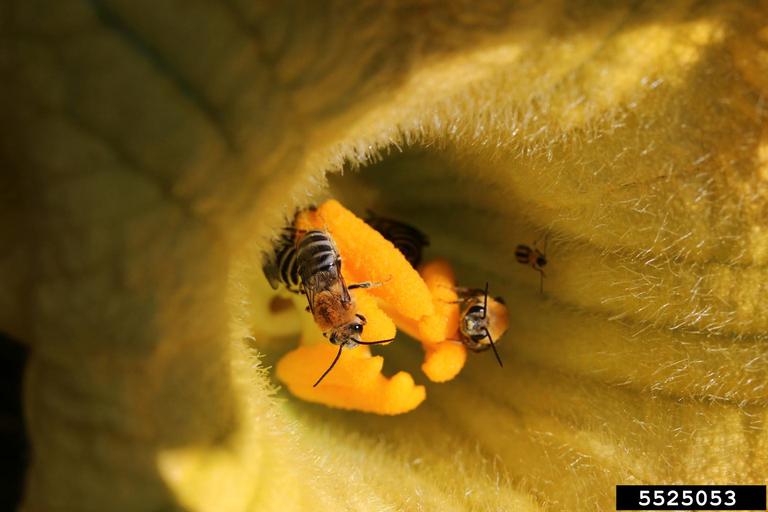
Jim Jasinski, Ohio State University Extension, Bugwood.org
Squash bees are specialists that derive their pollen from solely squashes, pumpkins, and gourds. Specialized pollinators have a higher chance of successful pollination than generalist pollinators because they are only visiting these specific crops in succession, vastly increasing the odds of pollen contact. They have specialized hair on their hind legs which is able to hold the large pollen of their selected vegetable species however, identification should not rely solely on the presence of these hairs as they are only possessed by female bees. These bees are stout, with comparable sizing to bumble bees, and also have large antennae and can be found often by their plants of choice. Squash bees are solitary and females will dig a burrow within the first 6 - 12 inches of ground. Because of this, conservation efforts of these bees focus on minimization of topsoil in areas that contain these bees.
Solitary ground nesting bees (Colletes, Agapostemon, Andrena, Halictus & Lasioglossum)

Whitney Cranshaw, Colorado State University, Bugwood.org
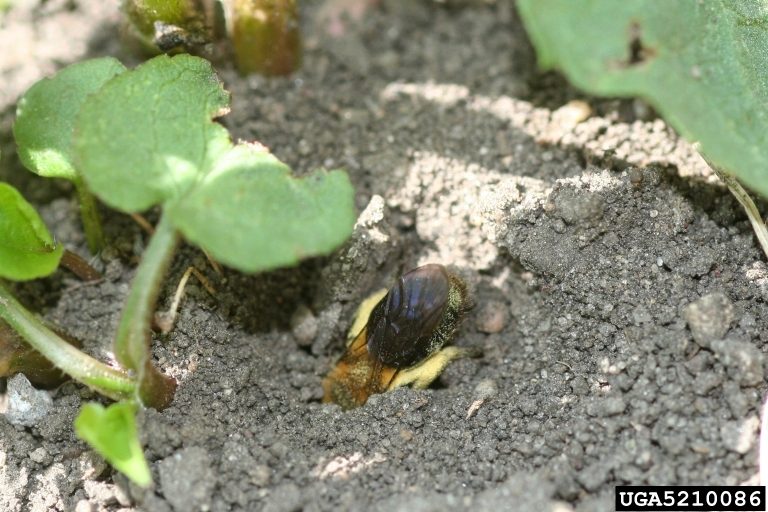
Whitney Cranshaw, Colorado State University, Bugwood.org
Solitary ground nesting bees encompass the majority of bee species in the world. All females dig nests that they inhibit and lay their eggs within. The walls on the tunnel are reinforced and waterproofed with a wax like secretion from the female and the larvae is left with a storage of pollen, scavenged by the female. These bees can be identified by the distinct shape of the entrance to their tunnels, which is a small, conical mound of soil. These bees will establish themselves and return to the same tunnel for multiple years. These tunnels are made in loose, dry soils, as the bees must dig them individually. They are not considered pests as they do not bore into wood to create nests and will only confront humans when highly provoked. If you identify these holes on your property, do not disturb the soil or flood the ground as this will lead to the eradication of these important pollinators.
Carpenter Bees (Xylocopa)

Jim Baker, North Carolina State University, Bugwood.org
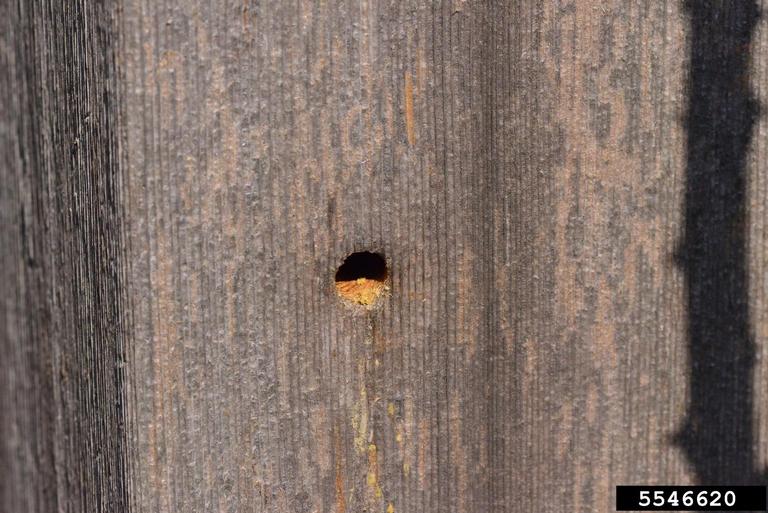
David L. Clement, University of Maryland, Bugwood.org
Carpenter bees are easily identifiable by the lack of hairs on their shiny abdomen. While they are often confused with bumble bees due to their similar appearance, they have vastly different behaviors and survival strategies. They bore holes in dead wood to be used as incubation chambers for their young. These tunnels have one entrance that is identifiable by a small, perfectly circle hole. Within these tunnels are multiple branch paths layered with capsules of developing larvae, each capsule equipped with an egg and a stockpile of pollen as a food source for development. The wood that is borne is not consumed by the bee, as they feed on nectar as adults, and pollen as larvae. These bees are often considered pests due to their damage to infrastructure such as homes. Management of these bees with the use of insecticide is not advisable due to the environmental ramifications of pesticides, and the eradication of a vital pollinator. An alternative is to paint or varnish exposed wood, which deters the bees. Aswell, the plugging of previously inhabited wood holes prevents the bees from reusing previous tunnels. There are also varieties of wood boring carpenter bees that are comparatively much smaller than the conventional appearance of wood boring bees. These bees have the same behaviors, however can have different correlations such as completely iridescent green. Carpenter bees are easily identifiable by the lack of hairs on their shiny abdomen. While they are often confused with bumble bees due to their similar appearance, they have vastly different behaviors and survival strategies. They bore holes in dead wood to be used as incubation chambers for their young. These tunnels have one entrance that is identifiable by a small, perfectly circle hole. Within these tunnels are multiple branch paths layered with capsules of developing larvae, each capsule equipped with an egg and a stockpile of pollen as a food source for development. The wood that is borne is not consumed by the bee, as they feed on nectar as adults, and pollen as larvae. These bees are often considered pests due to their damage to infrastructure such as homes. Management of these bees with the use of insecticide is not advisable due to the environmental ramifications of pesticides, and the eradication of a vital pollinator. An alternative is to paint or varnish exposed wood, which deters the bees. Aswell, the plugging of previously inhabited wood holes prevents the bees from reusing previous tunnels. There are also varieties of wood boring carpenter bees that are comparatively much smaller than the conventional appearance of wood boring bees. These bees have the same behaviors, however can have different correlations such as completely iridescent green.
Sweat Bees (Numerous Genera)
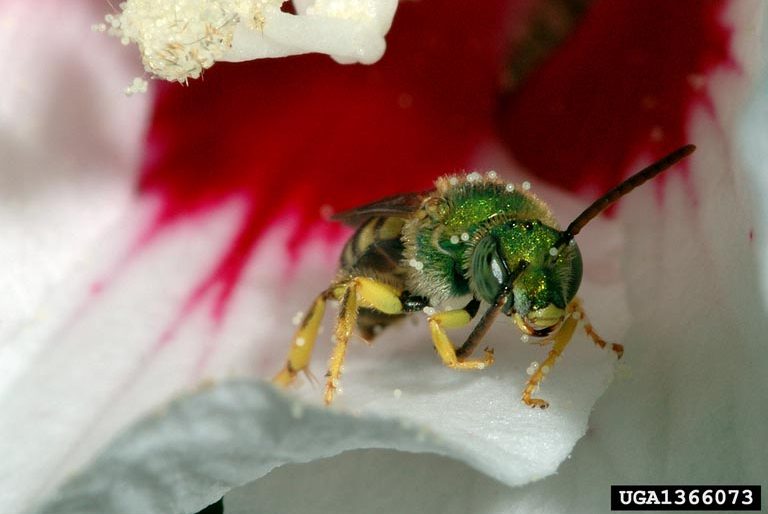
Susan Ellis, Bugwood.org

Joseph Berger, Bugwood.org
Sweat bees are a diverse group of bees that includes solitary, and eusocial varieties. Some sweat bees are even nocturnal, a unique characteristic of bees. The characterizing feature of these bees is a curved basal vein within the wings of these bees. They are often metallic black or green, though all species do not fit this mold. Many bore nests in media such as rotten wood to create tunnels for young and all provide stockpiles for their young, though some through parasitism. These bees have gained notoriety from their habit of flying close to humans and many times landing on them as a result of their attraction to the perspiration of humans. Because of this they have been dubbed as sweat bees.
Long Horned Bees (Melissodes)

Johnny N. Dell, Bugwood.org
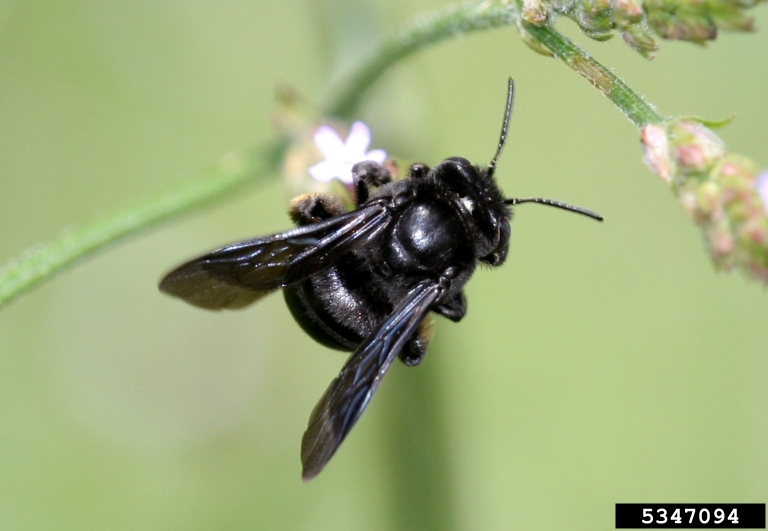
Johnny N. Dell, Bugwood.org
Long horned bees are identifiable by their elongated antennae. The females share this feature, however it is not as pronounced as the males, as well as feathery leg hairs for pollen collection. These are another species of ground boring bees that create shallow tunnels for larvae development. They are generalist pollinators with a preference for the aster family of plants, though they are proficient and prized for their capacity to pollinate squash, pumpkins and gourds. One identifying behavior is the males sleeping aggregations, in which multiple males will use their mandibles to latch onto a plant stem to sleep during the night. These pollinators are another example of beneficial that emphasize the importance of soil conservation.
Solitary Bees (Megachile)
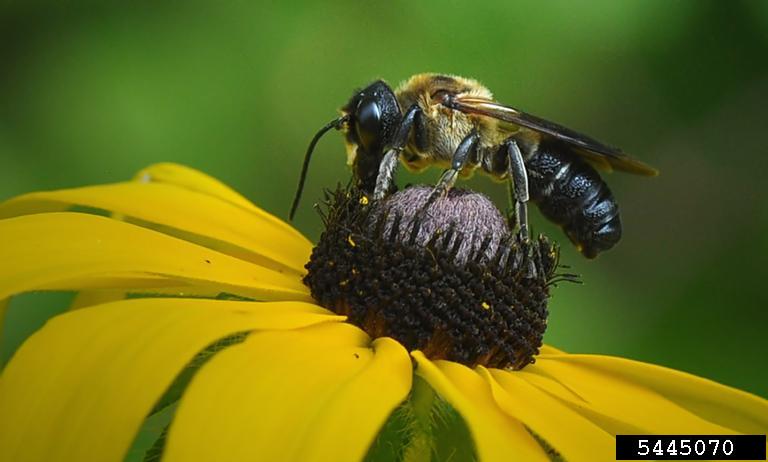
Jon Yuschock, Bugwood.org
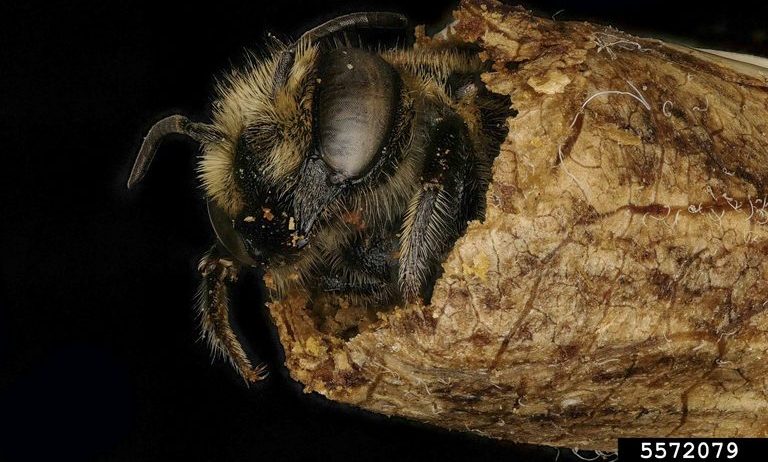
Chelsey Ritner, Exotic Bee ID, USDA APHIS PPQ, Bugwood.org
These bees, (often called mason or leafcutter bees) are solitary bees that can be identified by a unique mechanism in which they use to collect pollen. Many bees store pollen on hairs and “pollen baskets” located on their hind legs, however with the Megachilidae, the pollen holding hair structures instead encompass the entirety of the lower abdomen. Some parasitic species of these bees lack this pollen collection mechanism, using other bee’s stores of pollen to feed. These bees utilize pre-built cavities such as holes between stones to create similar larvae capsules to other boring bees. These bees obtained their nickname through the collection and utilization of materials such as leaves.
Plasterer Bees (Colletes)

Mary C Legg, Mary C Legg, Bugwood.org
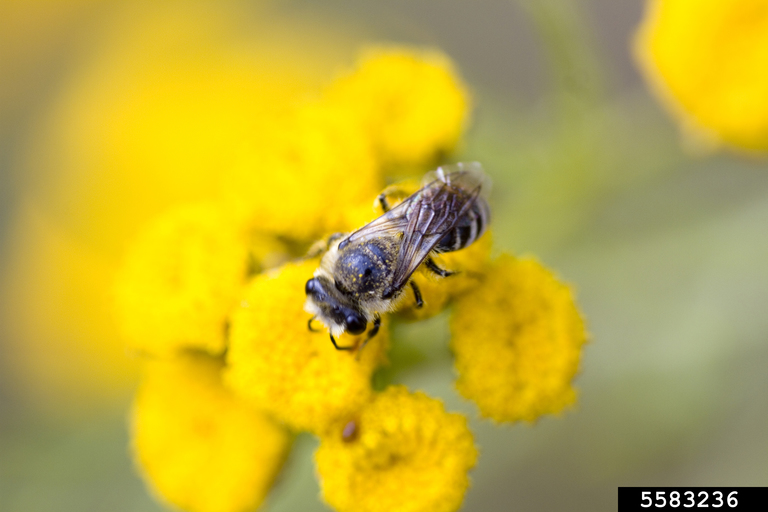
Mary C Legg, Mary C Legg, Bugwood.org